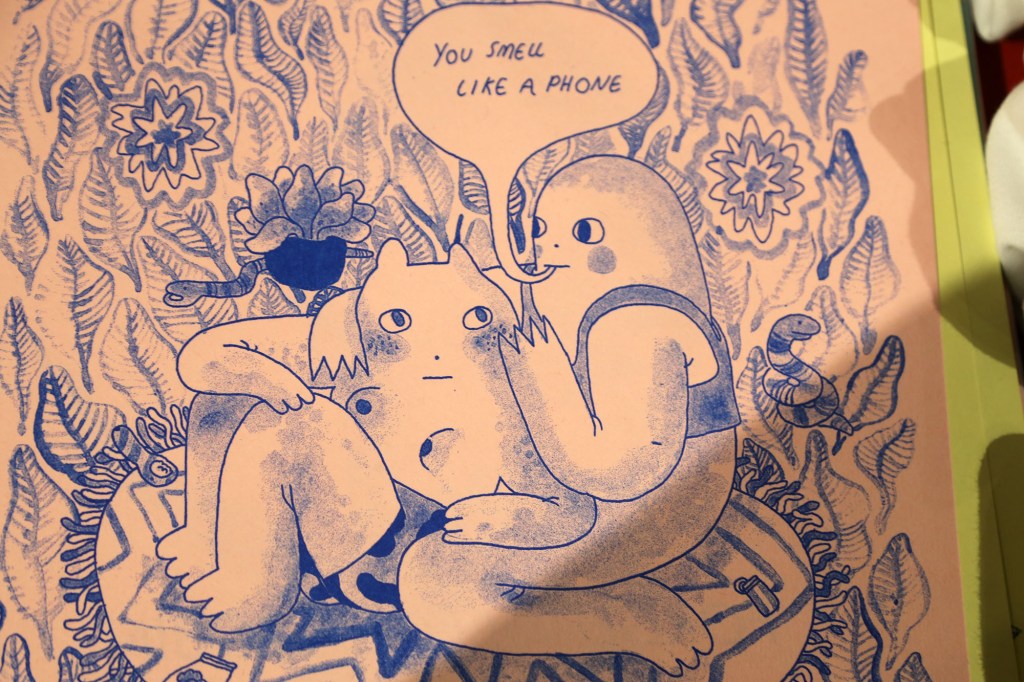Not sure if you guys heard, but Nancy is, for the first time since the Eisenhower administration, actually good.
The long-running newspaper strip, featuring the misadventures of the eponymous little girl and her delinquent pal Sluggo, has found new life under Olivia Jaimes, the pseudonym for the first female cartoonist to write and draw the daily comic in its 80 year history.
Videos by VICE
“I’m more or less a repressed Nancy,” Jaimes told me over email. “I’m extremely earnest and extremely hungry.”

Jaimes’ run began two months ago, but Nancy has been around since 1933, when the character was introduced by Ernie Bushmiller. In recent years, the strip has experienced a kind of critical renaissance among cartoonists like Matt Groening, Daniel Clowes, Chris Ware, and Art Spiegelman, who have all referenced their affection for Bushmiller’s work.
Last year, Fantagraphics published an extensively researched book, How To Read Nancy: The Elements of Comics in Three Easy Panels, in which authors Mark Newgarden and Paul Karasik argued that Bushmiller’s minimalist approach to joke-telling acts as a template for all sequential art, sort of like Hero of a Thousand Faces for the funny pages.
“It’s the Bushmiller Nancy that everyone remembers,” said John Glynn, president at Andrews McMeel Syndication, the company that publishes the strip.
“As much as we talk about Ernie Bushmiller, I feel like the spirit of the strip is tied less to any one person than to the joke structure itself,” said Jaimes. “A Nancy comic, to me, is an assemblage of elements that, taken together, have a nice kind of symmetry to them. The last panel is the right answer. I love that feeling, and I love Nancy for it.”

After Bushmiller’s death in 1982, Nancy continued under various creators. “We had known and liked Olivia’s work as a web cartoonist, and found out she was a huge Nancy fan, so we queried her,” Glynn told me. “After we got back her samples, we felt that we had found the right person.”
It’s a mystery as to which web comics she previously published, though. “If it was up to me, I’d rather use her real name,” Glynn said. “Her fans would’ve been incredible advocates, but she wants to keep her two lives separate, and we respect that.”
“I’m a pretty private person and I want to be insulated from the whole ‘Big Thing’ that a classic comic strip is,” Jaimes said of the pseudonym, speaking to the New York Times. “The pseudonym lets me do that, and I’m really grateful for it.”
“Nancy is the only legacy strip I would have even considered taking on,” Jaimes told me. “For any other, the cons—it’s somebody else’s baby, there will be grumblers—would have easily outweighed the pros.”

In Bushmiller’s hands, Nancy was always about the gag. Unlike Peanuts or Calvin and Hobbes or other such celebrated comics of later eras, the comic never went for melancholy or pathos; just jokes and absurdity. But, for the 20 years before Jaimes took over, Nancy had been written and drawn by Guy Gilchrist, who replaced punchlines with wistful Baby Boomer references to The Andrews Sisters and “The Facts of Life.”
The addition of bots, apps, video games and Snapchat succeeded in attracting coverage from the Times, The Washington Post, BoingBoing, and the AV Club, but sparked another front in the culture war. On one side, the regular commenters on GoComics.com, many of whom prefer Gilchrist, and post negative comments on each of Jaimes’s posts. On the other side, commenters on social media, who were extremely enthusiastic about the new direction. According to the Andrews McMeel, social engagement on the strip has gone up more than 500 percent.
For his part, Glynn told me his team had nothing but confidence in Jaimes. “Olivia is the only person who could’ve done it, to bring the Bushmiller style and the 21st century together. The sensibilities fit together perfectly,” he said.

It’s a testament to Jaimes’ strength as a writer and artist that the modernization doesn’t feel clumsy or forced. Instead, it’s obvious that Jaimes is of a generation that grew up with technology as an intuitive aspect of daily life. “I grimace when I hear the notification sound and think, ‘what new pain is this?’” Jaimes told me. “That said, I’m definitely nearing the point of being over it. I want to spend my money on products and tech that will keep me away from my current products and tech. I’d like to be dissatisfied in completely new ways.”
Besides the new look and nouns used, the takeaway here is that Nancy is funny again. Jaimes has succeeded in returning the original minimalist spirit to the comic, but surpasses it with far greater talent and sensibility. Jaimes cites Mitch Hedberg and Parks and Recreation as inspirations for her minimalist jokes, as well as memes because, in a way, what are memes but minimalist comic strips that anyone can make? “Memes have brought me a lot of joy,” Jaimes said.
One of the great joys of Nancy, like the best comedy characters, is she’s all id. She’s immature and impulsive, seeking only immediate gratification and unfettered comfort at all times. In comic strips, this is common with little boy characters, like Dennis the Menace or Calvin, but it’s hard to name another comedic female comic protagonist who is wholly defined by her negative traits and doesn’t feel ashamed of them.

“One of our criteria is, if we can read it and know the punchline, and still love it, and read it again — that’s when you know it’s good,” Glynn said. “The Bushmiller work does that, and I can re-read Olivia’s Nancy and laugh every time.”
“I’m humbled by the response,” Jaimes said. “Which might sound canned, but as mentioned, I’m super earnest about basically everything.”
Sign up for our newsletter to get the best of VICE delivered to your inbox daily.
Follow Grant Pardee on Twitter.



